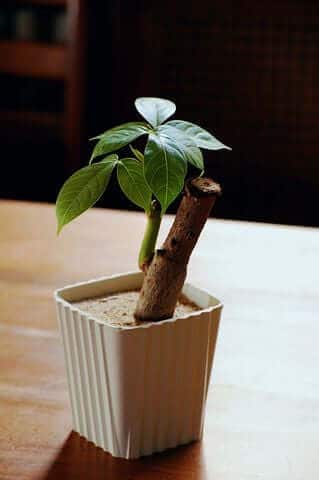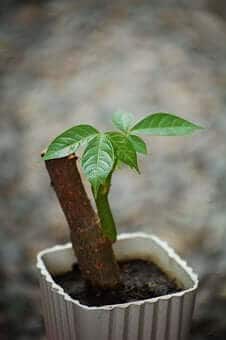Last Updated on January 23, 2023 by a Friendly Gardener
The idea of money growing on trees is an appealing one, but unfortunately, it’s not possible. You can, however, grow your very own Money Tree to bring you good luck. Botanically named the Pachira Aquatica, this plant is a member of the Malvaceae family. It is a delightful little tree to grow if you are looking for a hint of the tropics. The Money Tree finds its natural habitat in Mexico and some of the northern regions of South America, The Money tree vaguely resembles a palm tree.
In Feng Shui, the Money Tree brings good fortune and prosperity to the owner. Some unique characteristics of this tree are the vibrant green leaves canopying braided trunks. Braided trunks are not natural to this tree but a feature that is man-induced. A legend says that the braids trap good fortune in their folds.
When this tree grows in its native habitat, it has unbraided trunks that can grow to sixty feet high. The tree produces lovely yellow flowers. After flowers pass, oversized seed pods will follow. When cultivated indoors, the Money Tree will usually top out at six feet. The Money Trees sold in nurseries usually will feature braided trunks, as growers will braid them while younger trunks are flexible and still green. With age, trunks will harden and become woody in appearance.
Money Tree Care

When you are deciding on a spot in your home for your money tree, look for spots that are far out of the way of drafts. So, avoid drafty halls, windows, or doorways. Also, refrain from placing your tree near air conditioning and heating units and vents. When your tree is exposed to air currents, both hot and cold, leaf loss may follow. Steamy bathrooms with good light exposure are ideal places for these plants.
The Money Tree can be grown in outside gardens in USDA hardy zones 10 through 12. Indoors they thrive in a temperature that measures in the 65° to 75° Fahrenheit range. They are able to manage temperatures that fluctuate to as much as 10 degrees lower or higher.
Soil
Select a plant container that has a generous number of drainage holes. The best-growing medium for the Money Tree is a nutrient-rich, peat moss-based soil mix. Blend it with some sand to guarantee good drainage. Also, consider adding a small amount of gravel at the bottom of the tree pot to aid in drainage.
Light
The Money Tree, like most houseplants, prefers bright, indirect light. Direct sun exposure can burn and scorch the foliage. Luckily, these plants also are able to adapt to lower light conditions making them a great choice for homes, businesses, and offices, so don’t fear if you live in a home without much sunlight exposure. Rotate your plant regularly to achieve even all-around growth. This will ensure a homogeneous exposure to your light source. Resist the temptation to move your tree around a lot. Moving a plant often can disturb the plant’s general health.
Water
The Money Tree does not appreciate overwatering. Soil beds should be allowed to dry out almost entirely between one watering and the next. If the top 2 to 4 inches of the topsoil are dry, water thoroughly or soak until water runs out of the pot’s drainage holes.
Never leave this plant standing in water. Depending on your climate, you may be able to water weekly, or once every two weeks. In warmer, dryer climates, you’ll need to water more frequently.
Humidity
The Money Tree, with its tropical origins, likes humidity. If the location where you keep your plant is not overly humid or features very dry air, you’ll need to compensate. Consider placing a small space humidifier or a pebble tray near your plant. Fill the tray with pretty pebbles and partially cover them in water. Place your Money Tree on top of this tray. The plant’s pot should not touch the water underneath but sit slightly above it. You can also group the plants together to increase localized humidity. Grouping plants together creates a microclimate, so that when the plants transpire, vapor will enter the air surrounding the plants. You can also mist your Money Tree regularly.
Feeding
You can feed your Money Tree plant monthly during the growing season. Use a quality all-purpose liquid fertilizer that you have diluted to half strength. It will not be necessary to feed your plant in winter.
Braiding and Pruning

You may want to braid your tree trunks. The Money Tree does not require or need braiding. Most Money Trees sold in nurseries, flower shops, or gardening centers will feature trunk braiding. Braided Money Trees are not a single tree but a grouping of several individual plants together. Money tree growers braid the stems of several plants together while they are young and still growing. This is because stems are still green and flexible facilitating the braiding.
If you purchase several young plants together or grow your own plantlets from stem cuttings, you can braid these plants while still young. Gently weave the plant stems together and tie them loosely with a string. Tie around the top of the plant to keep stems together in the braided form. As the Money Tree grows taller braiding can be continued.
Pruning is occasionally necessary. Any damaged or dead foliage should be removed. Use sterile scissors to prevent the transferal of infections from one plant to another. When pruning, snip off near a leaf node. You might prune foliage tops into a specific shape if you want. Tops are usually round. Pruning stimulates new growth, but it is also a tool to manage your plant’s height.
Repotting

Repotting is important if you want the Money Tree to increase in size. You can repot your tree annually if you wish to encourage growth.
Pests, Diseases, and Problems
The Money Tree is at risk for all common houseplant pests and especially mealybugs and aphids. If you see evidence of an infestation, use organic horticultural oil like Neem oil. Apply the oil or insecticidal soap to the plant. Repeat as necessary.
The principal problems for cultivating the Money Tree Plant include overexposure to sunlight which causes the scorching of foliage and overwatering which causes root rot. Select a container that is not overly large for the Money Tree’s root ball. A larger pot requires more soil. More soil will hold more water and this can lead to root rot.
Money Tree Propagation

For Money Tree propagation, take a stem cutting from your plant using sterile cutting shears. The cutting needs to contain a minimum of two leaf nodes. Dip the stem’s cut end into the rooting hormone. Now position it in a pot with standard potting soil. Mist both the cutting and soil as much as necessary to keep them moist. Within a month, the cutting will develop roots and you can treat it as a young money tree plant.
Money Tree Toxicity
The ASPCA-American Society for the Prevention of Cruelty to Animals informs us that the Money Tree is non-toxic to both cats and dogs. However, should your kitty or pup eat some, it can cause an upset stomach characterized by diarrhea and vomiting.

